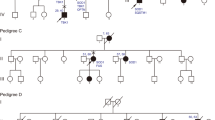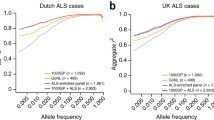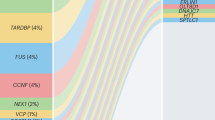Abstract
Background
Amyotrophic lateral sclerosis (ALS) is a neurodegenerative disease with complex genetic architecture. Emerging evidence has indicated comorbidity between ALS and autoimmune conditions, suggesting a potential shared genetic basis. The objective of this study is to assess the prognostic value of systematic screening for rare deleterious mutations in genes associated with ALS and aberrant inflammatory responses.
Methods
A discovery cohort of 494 patients and a validation cohort of 69 patients were analyzed in this study, with population-matched healthy subjects (n = 4961) served as controls. Whole exome sequencing (WES) was performed to identify rare deleterious variants in 50 ALS genes and 1177 genes associated with abnormal inflammatory responses. Genotype–phenotype correlation was assessed, and an integrative prognostic model incorporating genetic and clinical factors was constructed.
Results
In the discovery cohort, 8.1% of patients carried confirmed ALS variants, and an additional 15.2% of patients carried novel ALS variants. Gene burden analysis revealed 303 immune-implicated genes with enriched rare variants, and 13.4% of patients harbored rare deleterious variants in these genes. Patients with ALS variants exhibited a more rapid disease progression (HR 2.87 [95% CI 2.03–4.07], p < 0.0001), while no significant effect was observed for immune-implicated variants. The nomogram model incorporating genetic and clinical information demonstrated improved accuracy in predicting disease outcomes (C-index, 0.749).
Conclusion
Our findings enhance the comprehension of the genetic basis of ALS within the Chinese population. It also appears that rare deleterious mutations occurring in immune-implicated genes exert minimal influence on the clinical trajectories of ALS patients.




Similar content being viewed by others
Data availability
The summary of genetic alterations in ALS patients analyzed during this study is included in the supplementary files and deposited in the Genome Variation Map (GVM) in National Genomics Data Center, Beijing Institute of Genomics, Chinese Academy of Sciences and China National Center for Bioinformation, under accession number GVM000588. Individual-level sequencing data are available from the corresponding authors on reasonable request.
Abbreviations
- ACMG:
-
American College of Medical Genetics and Genomics
- ALS:
-
Amyotrophic lateral sclerosis
- ALS-MiToS:
-
Milano-Torino Staging for Amyotrophic Lateral Sclerosis
- ALSFRS-R:
-
ALS Functional Rating Scale–Revised
- BMI:
-
Body mass index
- cGAS-STING:
-
Cyclic GMP-AMP synthase-stimulator of interferon genes
- CI:
-
Confidence interval
- ENCALS:
-
European Network for the Cure of ALS
- fALS:
-
Familial ALS
- FTD:
-
Frontotemporal dementia
- GATK:
-
Genome analysis toolkits
- HR:
-
Hazard ratio
- MAF:
-
Minor allele frequency
- PUMCH:
-
Peking Union Medical College Hospital
- ROADS:
-
Rasch-Built Overall Amyotrophic Lateral Sclerosis Disability Scale
- sALS:
-
Sporadic ALS
- VUS:
-
Variants of unknown significance
- WES:
-
Whole exome sequencing
References
Swinnen B, Robberecht W (2014) The phenotypic variability of amyotrophic lateral sclerosis. Nat Rev Neurol 10:661–670. https://doi.org/10.1038/nrneurol.2014.184
Hardiman O, Al-Chalabi A, Chio A et al (2017) Amyotrophic lateral sclerosis. Nat Rev Dis Prim 3:17071. https://doi.org/10.1038/nrdp.2017.71
Goutman SA, Hardiman O, Al-Chalabi A et al (2022) Recent advances in the diagnosis and prognosis of amyotrophic lateral sclerosis. Lancet Neurol 21:480–493. https://doi.org/10.1016/S1474-4422(21)00465-8
Ying W (2023) Phenomic studies on diseases: potential and challenges. Phenomics 3:285–299. https://doi.org/10.1007/s43657-022-00089-4
Picard M (2022) Why do we care more about disease than health? Phenomics 2:145–155. https://doi.org/10.1007/s43657-021-00037-8
Goutman SA, Hardiman O, Al-Chalabi A et al (2022) Emerging insights into the complex genetics and pathophysiology of amyotrophic lateral sclerosis. Lancet Neurol 21:465–479. https://doi.org/10.1016/S1474-4422(21)00414-2
Al-Chalabi A, Hardiman O (2013) The epidemiology of ALS: a conspiracy of genes, environment and time. Nat Rev Neurol 9:617–628. https://doi.org/10.1038/nrneurol.2013.203
He D, Cui L (2021) Assessing the causal role of selenium in amyotrophic lateral sclerosis: a mendelian randomization study. Front Genet 12:1–6. https://doi.org/10.3389/fgene.2021.724903
Liu B, Lyu L, Zhou W et al (2023) Associations of the circulating levels of cytokines with risk of amyotrophic lateral sclerosis : a Mendelian randomization study. BMC Med. https://doi.org/10.1186/s12916-023-02736-7
Julian TH, Glascow N, Fisher AD et al (2021) Physical exercise is a risk factor for amyotrophic lateral sclerosis: convergent evidence from Mendelian randomisation, transcriptomics and risk genotypes. EBioMedicine 68:103397. https://doi.org/10.1016/j.ebiom.2021.103397
Alipour P, Senkevich K, Ross JP et al (2022) Investigation of the causal relationship between ALS and autoimmune disorders : a Mendelian randomization study. BMC Med. https://doi.org/10.1186/s12916-022-02578-9
Shepheard SR, Parker MD, Cooper-Knock J et al (2021) Value of systematic genetic screening of patients with amyotrophic lateral sclerosis. J Neurol Neurosurg Psychiatry. https://doi.org/10.1136/jnnp-2020-325014
Opie-Martin S, Iacoangeli A, Topp SD et al (2022) The SOD1-mediated ALS phenotype shows a decoupling between age of symptom onset and disease duration. Nat Commun 13:1–9. https://doi.org/10.1038/s41467-022-34620-y
Dong S, Yin X, Wang K et al (2023) Presence of rare variants is associated with poorer survival in chinese patients with amyotrophic lateral sclerosis. Phenomics 3:167–181. https://doi.org/10.1007/s43657-022-00093-8
Chio A, Moglia C, Canosa A et al (2023) Association of copresence of pathogenic variants related to amyotrophic lateral sclerosis and prognosis. Neurology. https://doi.org/10.1212/WNL.0000000000207367.10.1212/WNL.0000000000207367
Chia R, Chiò A, Traynor BJ (2018) Novel genes associated with amyotrophic lateral sclerosis: diagnostic and clinical implications. Lancet Neurol 17:94–102. https://doi.org/10.1016/S1474-4422(17)30401-5
Saez-Atienzar S, Bandres-Ciga S, Langston RG et al (2021) Genetic analysis of amyotrophic lateral sclerosis identifies contributing pathways and cell types. Sci Adv 7:1–14. https://doi.org/10.1126/sciadv.abd9036
Feldman EL, Goutman SA, Petri S et al (2022) Amyotrophic lateral sclerosis. Lancet 400:1363–1380. https://doi.org/10.1016/S0140-6736(22)01272-7
Coque E, Salsac C, Espinosa-Carrasco G et al (2019) Cytotoxic CD8 + T lymphocytes expressing ALS-causing SOD1 mutant selectively trigger death of spinal motoneurons. Proc Natl Acad Sci U S A 116:2312–2317. https://doi.org/10.1073/pnas.1815961116
Yu CH, Davidson S, Harapas CR et al (2020) TDP-43 triggers mitochondrial DNA release via mPTP to activate cGAS/STING in ALS. Cell 183:636-649.e18. https://doi.org/10.1016/j.cell.2020.09.020
McCauley ME, O’Rourke JG, Yáñez A et al (2020) C9orf72 in myeloid cells suppresses STING-induced inflammation. Nature 585:96–101. https://doi.org/10.1038/s41586-020-2625-x
Wei Q, Chen Y, Chen X et al (2018) Prognostic nomogram associated with longer survival in amyotrophic lateral sclerosis patients. Aging Dis. 9:965. https://doi.org/10.14336/AD.2017.1016
Liu L, Zhu S (2021) computational methods for prediction of human protein-phenotype associations: a review. Phenomics 1:171–185. https://doi.org/10.1007/s43657-021-00019-w
Westeneng HJ, Debray TPA, Visser AE et al (2018) Prognosis for patients with amyotrophic lateral sclerosis: development and validation of a personalised prediction model. Lancet Neurol 17:423–433. https://doi.org/10.1016/S1474-4422(18)30089-9
Shen D, Cui B, Liu M et al (2020) Strategy for screening cognitive impairment in Chinese patients with amyotrophic lateral sclerosis. J Clin Neurosci 81:105–110. https://doi.org/10.1016/j.jocn.2020.09.016
Hao M, Pu W, Li Y et al (2021) The HuaBiao project: whole-exome sequencing of 5000 Han Chinese individuals. J Genet Genomics 48:1032–1035. https://doi.org/10.1016/j.jgg.2021.07.013
He D, Shang L, Liu Q et al (2021) Association of apolipoprotein E ε4 allele and amyotrophic lateral sclerosis in Chinese population. Amyotroph Lateral Scler Front Degener. https://doi.org/10.1080/21678421.2021.1953077
Richards S, Aziz N, Bale S et al (2015) Standards and guidelines for the interpretation of sequence variants: A joint consensus recommendation of the American College of Medical Genetics and Genomics and the Association for Molecular Pathology. Genet Med 17:405–424. https://doi.org/10.1038/gim.2015.30
Li Q, Wang K (2017) InterVar: clinical interpretation of genetic variants by the 2015 ACMG-AMP guidelines. Am J Hum Genet 100:267–280. https://doi.org/10.1016/j.ajhg.2017.01.004
Jagadeesh KA, Wenger AM, Berger MJ et al (2016) M-CAP eliminates a majority of variants of uncertain significance in clinical exomes at high sensitivity. Nat Genet 48:1581–1586. https://doi.org/10.1038/ng.3703
Schwarz JM, Cooper DN, Schuelke M, Seelow D (2014) Mutationtaster2: mutation prediction for the deep-sequencing age. Nat Methods 11:361–362. https://doi.org/10.1038/nmeth.2890
Ioannidis NM, Rothstein JH, Pejaver V et al (2016) REVEL: an ensemble method for predicting the pathogenicity of rare missense variants. Am J Hum Genet 99:877–885. https://doi.org/10.1016/j.ajhg.2016.08.016
Glass JD, Dewan R, Ding J et al (2022) ATXN2 intermediate expansions in amyotrophic lateral sclerosis. Brain 145:2671–2676. https://doi.org/10.1093/brain/awac167
Wu MC, Lee S, Cai T et al (2011) Rare-variant association testing for sequencing data with the sequence kernel association test. Am J Hum Genet 89:82–93. https://doi.org/10.1016/j.ajhg.2011.05.029
Chen YP, Yu SH, Wei QQ et al (2022) Role of genetics in amyotrophic lateral sclerosis: a large cohort study in Chinese mainland population. J Med Genet 59:840–849. https://doi.org/10.1136/jmedgenet-2021-107965
Chen W, Xie Y, Zheng M et al (2020) Clinical and genetic features of patients with amyotrophic lateral sclerosis in southern China. Eur J Neurol 27:1017–1022. https://doi.org/10.1111/ene.14213
Liu ZJ, Lin HX, Wei Q et al (2019) Genetic spectrum and variability in Chinese patients with amyotrophic lateral sclerosis. Aging Dis. 10:1199–1206. https://doi.org/10.14336/AD.2019.0215
Van Rheenen W, Shatunov A, Dekker AM et al (2016) Genome-wide association analyses identify new risk variants and the genetic architecture of amyotrophic lateral sclerosis. Nat Genet 48:1043–1048. https://doi.org/10.1038/ng.3622
Kim G, Gautier O, Tassoni-Tsuchida E et al (2020) ALS genetics: gains, losses, and implications for future therapies. Neuron. https://doi.org/10.1016/j.neuron.2020.08.022
van Es MA, Hardiman O, Chio A et al (2017) Amyotrophic lateral sclerosis. Lancet 390:2084–2098. https://doi.org/10.1016/S0140-6736(17)31287-4
Grassano M, Calvo A, Moglia C et al (2021) Mutational analysis of known ALS genes in an Italian population-based cohort. Neurology 96:e600–e609. https://doi.org/10.1212/WNL.0000000000011209
Grassano M, Calvo A, Moglia C et al (2022) Systematic evaluation of genetic mutations in ALS: A population-based study. J Neurol Neurosurg Psychiatry. https://doi.org/10.1136/jnnp-2022-328931
McCann EP, Henden L, Fifita JA et al (2021) Evidence for polygenic and oligogenic basis of Australian sporadic amyotrophic lateral sclerosis. J Med Genet 58:87–95. https://doi.org/10.1136/jmedgenet-2020-106866
Al-Chalabi A, Calvo A, Chio A et al (2014) Analysis of amyotrophic lateral sclerosis as a multistep process: a population-based modelling study. Lancet Neurol 13:1108–1113. https://doi.org/10.1016/S1474-4422(14)70219-4
Li C, Ji Y, Tang L et al (2015) Optineurin mutations in patients with sporadic amyotrophic lateral sclerosis in China. Amyotroph Lateral Scler Front Degener 16:485–489. https://doi.org/10.3109/21678421.2015.1089909
Van Blitterswijk M, Van Es MA, Hennekam EAM et al (2012) Evidence for an oligogenic basis of amyotrophic lateral sclerosis. Hum Mol Genet 21:3776–3784. https://doi.org/10.1093/hmg/dds199
Bali T, Self W, Liu J et al (2017) Defining SOD1 ALS natural history to guide therapeutic clinical trial design. J Neurol Neurosurg Psychiatry 88:99–105. https://doi.org/10.1136/jnnp-2016-313521
Mccauley ME, Baloh RH (2019) Inflammation in ALS/FTD pathogenesis. Acta Neuropathol 137:715–730. https://doi.org/10.1007/s00401-018-1933-9
He D, Xu Y, Liu M, Cui L (2023) The inflammatory puzzle: piecing together the links between neuroinflammation and amyotrophic lateral sclerosis. Aging Dis. https://doi.org/10.14336/AD.2023.0519
Beers DR, Zhao W, Wang J et al (2017) ALS patients’ regulatory T lymphocytes are dysfunctional, and correlate with disease progression rate and severity. JCI Insight 2:1–14. https://doi.org/10.1172/jci.insight.89530
Murdock BJ, Zhou T, Kashlan SR et al (2017) Correlation of peripheral immunity with rapid amyotrophic lateral sclerosis progression. JAMA Neurol 74:1446. https://doi.org/10.1001/jamaneurol.2017.2255
Turner MR, Goldacre R, Ramagopalan S et al (2013) Autoimmune disease preceding amyotrophic lateral sclerosis: an epidemiologic study. Neurology 81:1222–1225. https://doi.org/10.1212/WNL.0b013e3182a6cc13
Chiot A, Zaïdi S, Iltis C et al (2020) Modifying macrophages at the periphery has the capacity to change microglial reactivity and to extend ALS survival. Nat Neurosci 23:1339–1351. https://doi.org/10.1038/s41593-020-00718-z
Sheean RK, McKay FC, Cretney E et al (2018) Association of regulatory T-Cell expansion with progression of amyotrophic lateral sclerosis a study of humans and a transgenic mouse model. JAMA Neurol 75:681–689. https://doi.org/10.1001/jamaneurol.2018.0035
Fournier CN, Bedlack R, Quinn C et al (2020) Development and validation of the Rasch-Built Overall Amyotrophic Lateral Sclerosis Disability Scale (ROADS). JAMA Neurol 77:480–488. https://doi.org/10.1001/jamaneurol.2019.4490
Roche JC, Rojas-Garcia R, Scott KM et al (2012) A proposed staging system for amyotrophic lateral sclerosis. Brain 135:847–852. https://doi.org/10.1093/brain/awr351
Chiò A, Hammond ER, Mora G et al (2015) Development and evaluation of a clinical staging system for amyotrophic lateral sclerosis. J Neurol Neurosurg Psychiatry 86:38–44. https://doi.org/10.1136/jnnp-2013-306589
Rooney J, Burke T, Vajda A et al (2017) What does the ALSFRS-R really measure? A longitudinal and survival analysis of functional dimension subscores in amyotrophic lateral sclerosis. J Neurol Neurosurg Psychiatry 88:381–385. https://doi.org/10.1136/jnnp-2016-314661
Lek M, Karczewski KJ, Minikel EV et al (2016) Analysis of protein-coding genetic variation in 60,706 humans. Nature 536:285–291. https://doi.org/10.1038/nature19057
Acknowledgements
The authors acknowledge the kind support from the patients and their families for their participation in this study. They also thank Beijing Grandomics Biosciences Co Ltd. for coding support.
Funding
This work was supported by the Strategic Priority Research Program (Pilot study) “Biological basis of aging and therapeutic strategies” of the Chinese Academy of Sciences (Grant number: XDB39040000), CAMS Innovation Fund for Medical Sciences (2021-I2M-1–003, 2019-I2M-5-066), National Science Foundation of China (32288101, 32200536, 82371431), Shanghai Municipal Science and Technology Major Project (2017SHZDZX01), and 2020 Medical Service and Support Capacity Improvement Project: Construction of the Cohort-Based Multidisciplinary Accurate Diagnosis and Treatment Platform for Neurological Autoimmune and Infectious Diseases.
Author information
Authors and Affiliations
Contributions
DH and LC: contributed to study concept and design. All the authors performed acquisition, analysis, or interpretation of data. DH: drafted the manuscript. All the authors were involved in critical revision of the manuscript for important intellectual content. DH, YL, and SD: performed statistical analysis. LC, XC, and JW obtained funding. LC, XC, and JW: supervised the study.
Corresponding authors
Ethics declarations
Conflict of interest
There is no conflict of interest to be disclosed.
Ethical approval and consent to participate
Ethical approval for this study was obtained from the PUMCH Research Ethical Boards (No. JS-2624). All participants have provided written consent or given permission for a relative to sign on their behalf.
Declaration of generative AI and AI-assisted technologies in the writing process
No generative AI or AI-assisted technologies have been used in the writing process.
Supplementary Information
Below is the link to the electronic supplementary material.
415_2023_12079_MOESM1_ESM.xlsx
Supplementary Table S1. ALS-implicated gene panel (HP:0007354). Table S2. Immune-implicated gene panel (HP:0012647). Table S3. List of identified rare deleterious ALS variants in the discovery cohort. Table S4. List of immune-implicated genes with enriched rare variants by SKAT analysis after Bonferroni correction. Table S5. List of identified rare deleterious immune variants in the discovery cohort. Table S6. List of identified rare deleterious immune variants in the validation cohort. Table S7. List of identified rare deleterious immune variants in the validation cohort. file1 (XLSX 2651 KB)
Rights and permissions
Springer Nature or its licensor (e.g. a society or other partner) holds exclusive rights to this article under a publishing agreement with the author(s) or other rightsholder(s); author self-archiving of the accepted manuscript version of this article is solely governed by the terms of such publishing agreement and applicable law.
About this article
Cite this article
He, D., Liu, Y., Dong, S. et al. The prognostic value of systematic genetic screening in amyotrophic lateral sclerosis patients. J Neurol 271, 1385–1396 (2024). https://doi.org/10.1007/s00415-023-12079-1
Received:
Revised:
Accepted:
Published:
Issue Date:
DOI: https://doi.org/10.1007/s00415-023-12079-1




